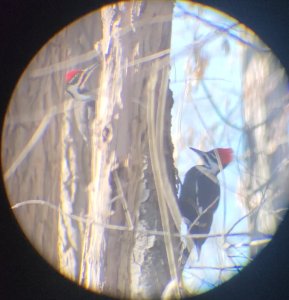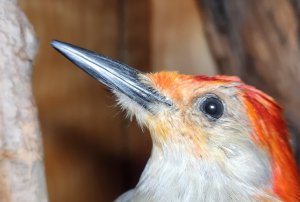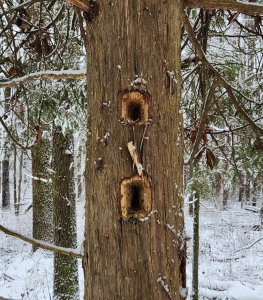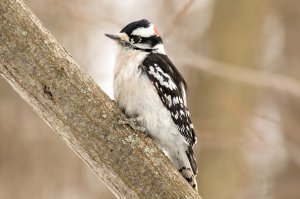Wild Homemakers: Woodpeckers
November 6, 2024
By: Ali Groulx, Park Interpreter
Knock, knock, knock. I look up – woodchips are flying, left and right. My eye catches a red

flash, then black, then white – what I recognize as a pileated woodpecker, repositioning itself to chip away at a hole in a cherry tree. In that moment in the forest, I was witnessing the power of the ultimate treehouse builder, a landlord of the leaves. Over time, many animals will find safety and shelter in that very hole, like owls, weasels, squirrels, wood ducks, and even more woodpeckers. With heartwood exposed to the elements, the presumably unhealthy cherry tree will decline soon, setting into motion a never-ending cycle of decay and regeneration, increasing to the nutrients available upon the forest floor. Woodpeckers are prolific, lifelong ecosystem engineers who have evolved in perfect step with the ecosystems they support.
PSA: Wear Your Helmets!
Six kinds of woodpeckers are native to Michigan, and all of them are born with the tools they will need to create homes for themselves. Their chiseled beaks make quick work of

soft wood, though that takes a toll on the brain without a helmet. Woodpecker’s tongues extend into their skulls, wrapping around their brains to create a cushion to absorb the impact. In lieu of goggles, they close their eyes as they are about to strike to protect from flying woodchips. Stiff tail feathers keep them upright and sturdy on the tree, further assisted by their zygodactyl, x-shaped feet that pinch the bark. A woodpecker’s body has evolved the precautions necessary for all the dangers of the important job of homemaking.
Rot Through the Heart, and Woodpecker’s to Blame
A woodpecker’s generosity is at its paramount when they choose to create a home in an unhealthy tree. The new, beak inflicted wounds will likely let in water that will seep into the heartwood. As the tree deteriorates further, the nooks and crannies will host a wide array of lifeforms. Even before their new families are raised within the tree cavity, tiny ecosystems have been created and the cycle of nutrients has started. A woodpecker’s efforts to survive change the world around them in mysterious ways.

Over their lifetimes, woodpeckers create a diverse array of holes in all shapes and sizes. Woodpeckers tend to roost alone or with their partners, thus save for the breeding season, they prefer to be solitary. Larger cavities are intended for raising families and must have an abundance of food nearby. Most nestlings are ready to move on after one month but tend to stick around their home neighborhoods. With the plethora of already-carved real estate, the unskilled juvenile woodpecker is spoiled for choice when it comes to their next roosting spot. Eventually, the young will disperse to drill homes of their own. Their legacies are an invaluable resource – many, many holes in trees.

A house is not a home until you fill it with warmth and love. As humans, we have the capacity to understand the feelings associated with ‘home.’ Woodpeckers support an unfathomable amount of life just by creating homes. Though their time with family may be short lived, the homes they facilitate for others fill the void of familiar love as we understand it. Like many, I do not know who built most of the places I’ve lived over the years, though I am grateful to them regardless. Home is a place you feel secure and protected, somewhere you can raise a family of your own or just chill by yourself. Home is wherever you want it to be – and if you are lucky, it’s inside a beautiful, spacious woodpecker cavity.
Wondering about other animal homes? In a fortnight, we will discuss an animal who builds colonies and boosts economies, and their equally impressive and often overlooked ‘little brother.’ Any guesses to who it will be? Stay tuned!
